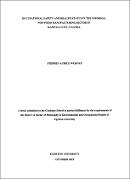| dc.description.abstract | The informal sector is an engine of growth with more than 1.8 billion people globally and one billion workers in developing countries producing a greater portion of GD (25-60%) in developing countries. It provides employment opportunities to majority of the population in bod! developing and developed countries. However the sector is unregulated and recorded in government statistics. There are high and tragic incidences of occupational related accidents and injuries that go unabated in Kampala. The purpose of the study was to assess the OSH status in the informal non-food manufacturing sector and identify interventions in Kampala A cross sectional survey design was used, both qualitative and quantitative data
were collected. 424 firms were sampled; manufiicture of metal products, furniture, textiles and clothing, concrete and brick, paper and paper recycling, repair of machinery and other manufacturing sectors of the informal sector. Data on hazards and control measures, lr.nowledge, attitudes, administrative measures and compliance were obtained using questionnaires, checklists and interview, on OSH Legal framework were obtained from JLO OSH conventions, Acts, textbooks and government reports and analyzed into frequencies, pm::entages, chi-square and multivariate regression. Various types of hazards were identified; inadequate ventilation 66 (50.4%), optical radiation 55 (44%), extreme weather 88 (37.4%), extreme heat 71 (34.3%), extreme noise 79 (27.9"/o), in manufacture of metal products. Noxious gases 91 (26.7%) and paints 66 (19.5%) in furniture and metal products while sharps 77 (21.3%) were in manufacture of metal products. Ergonomic hazards heavy lifting 67
(19.5%) in metallic products and psychosocial hazards such as stress accounted for 105 (30.5%) in metal products. Factors affecting OSH practices at p< 0.05 were; age x2 = 51.3,
gender x2 = 23.9, marital status x2 = 17.1, education level x•= 147.3, period working in Jua
lcoli x2• = 87.5, number of employees at work x2 =69.9 and hours spend per day x2 = 19.8 while the CORs were; age 0.0467- 0.0478, gender 0.0918-0.0997, education level 0.0859-
0.0819, PPE usage 0.0317-0.0319). All the enterprises Jacked awareness on OSH regulations, workplace OSH policies and certificates of machinery inspection. Knowledge of occupational hazards and control measures was moderate 271 (70%) while attitude towards hazard control measures by complying with safety precautions was very poor (below 16%). Compliance with hazard control measures was low, however PPE usage was 254 (65.4%) and 239 (61.6%) applying hazard control measures in the informal sector. Creation of awareness through mass media, training and awareness, provision of OSH regulations and regulation by government were recommended. | en_US |

